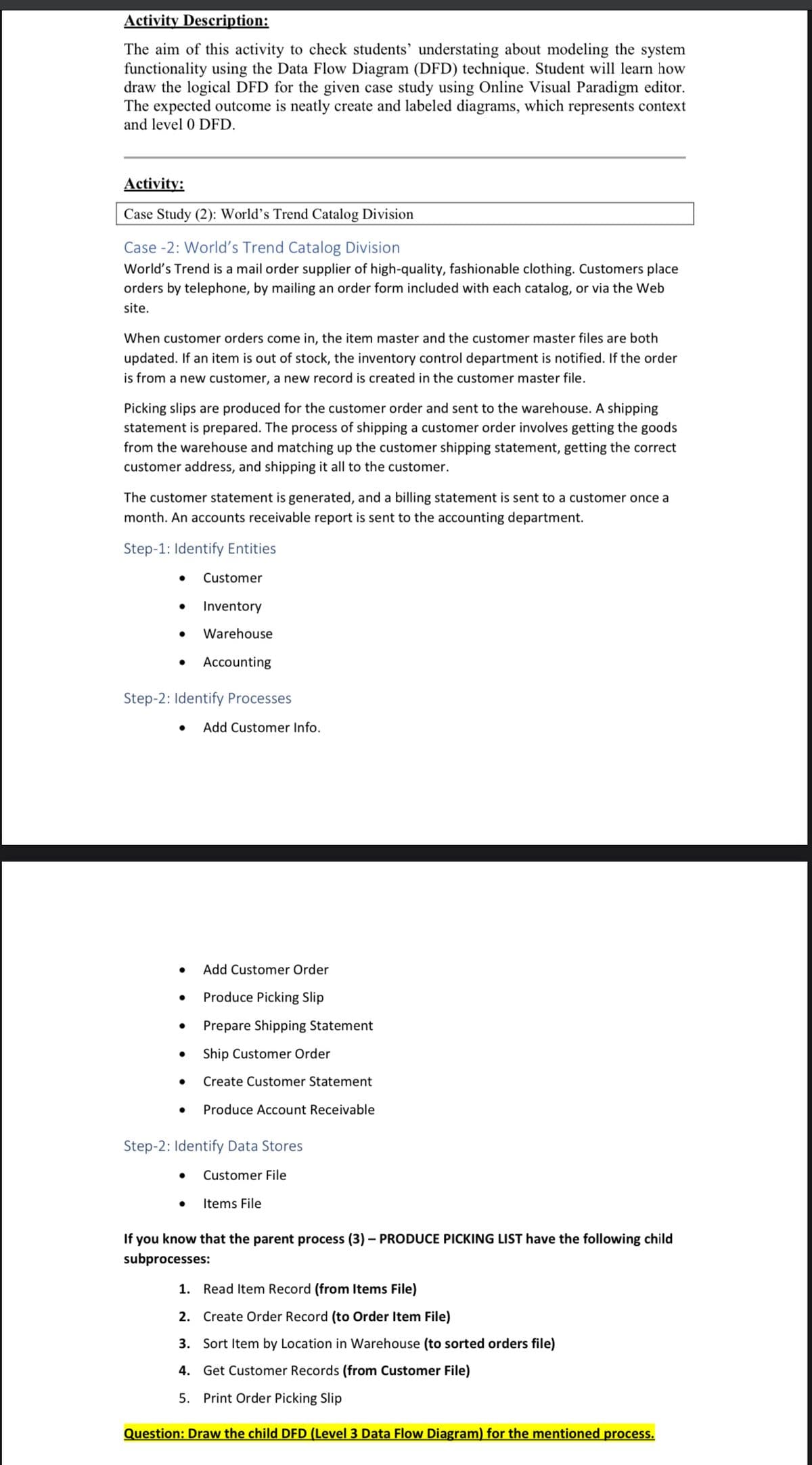Activity Description: The aim of this activity to check students' understating about modeling the system functionality using the Data Flow Diagram (DFD) technique. Student will learn how draw the logical DFD for the given case study using Online Visual Paradigm editor. The expected outcome is neatly create and labeled diagrams, which represents context and level 0 DFD.
Activity Description: The aim of this activity to check students' understating about modeling the system functionality using the Data Flow Diagram (DFD) technique. Student will learn how draw the logical DFD for the given case study using Online Visual Paradigm editor. The expected outcome is neatly create and labeled diagrams, which represents context and level 0 DFD.
Principles of Information Systems (MindTap Course List)
12th Edition
ISBN:9781285867168
Author:Ralph Stair, George Reynolds
Publisher:Ralph Stair, George Reynolds
Chapter12: Systems Development: Investigation, Analysis, And Design
Section: Chapter Questions
Problem 12SAT: Data modeling is most often accomplished through the use of a(n) __________________. a....
Related questions
Question
how do i solve it

Transcribed Image Text:Activity Description:
The aim of this activity to check students' understating about modeling the system
functionality using the Data Flow Diagram (DFD) technique. Student will learn how
draw the logical DFD for the given case study using Online Visual Paradigm editor.
The expected outcome is neatly create and labeled diagrams, which represents context
and level 0 DFD.
Activity:
Case Study (2): World's Trend Catalog Division
Case -2: World's Trend Catalog Division
World's Trend is a mail order supplier of high-quality, fashionable clothing. Customers place
orders by telephone, by mailing an order form included with each catalog, or via the Web
site.
When customer orders come in, the item master and the customer master files are both
updated. If an item is out of stock, the inventory control department is notified. If the order
is from a new customer, a new record is created in the customer master file.
Picking slips are produced for the customer order and sent to the warehouse. A shipping
statement is prepared. The process of shipping a customer order involves getting the goods
from the warehouse and matching up the customer shipping statement, getting the correct
customer address, and shipping it all to the customer.
The customer statement is generated, and a billing statement is sent to a customer once a
month. An accounts receivable report is sent to the accounting department.
Step-1: Identify Entities
Customer
● Inventory
Warehouse
● Accounting
Step-2: Identify Processes
● Add Customer Info.
Add Customer Order
● Produce Picking Slip
●
Prepare Shipping Statement
● Ship Customer Order
Create Customer Statement
Produce Account Receivable
Step-2: Identify Data Stores
● Customer File
Items File
If you know that the parent process (3) - PRODUCE PICKING LIST have the following child
subprocesses:
1. Read Item Record (from Items File)
2. Create Order Record (to Order Item File)
3. Sort Item by Location in Warehouse (to sorted orders file)
4. Get Customer Records (from Customer File)
5. Print Order Picking Slip
Question: Draw the child DFD (Level 3 Data Flow Diagram) for the mentioned process.
Expert Solution
This question has been solved!
Explore an expertly crafted, step-by-step solution for a thorough understanding of key concepts.
Step by step
Solved in 2 steps with 1 images

Knowledge Booster
Learn more about
Need a deep-dive on the concept behind this application? Look no further. Learn more about this topic, computer-science and related others by exploring similar questions and additional content below.Recommended textbooks for you

Principles of Information Systems (MindTap Course…
Computer Science
ISBN:
9781285867168
Author:
Ralph Stair, George Reynolds
Publisher:
Cengage Learning

C++ for Engineers and Scientists
Computer Science
ISBN:
9781133187844
Author:
Bronson, Gary J.
Publisher:
Course Technology Ptr

Principles of Information Systems (MindTap Course…
Computer Science
ISBN:
9781285867168
Author:
Ralph Stair, George Reynolds
Publisher:
Cengage Learning

C++ for Engineers and Scientists
Computer Science
ISBN:
9781133187844
Author:
Bronson, Gary J.
Publisher:
Course Technology Ptr